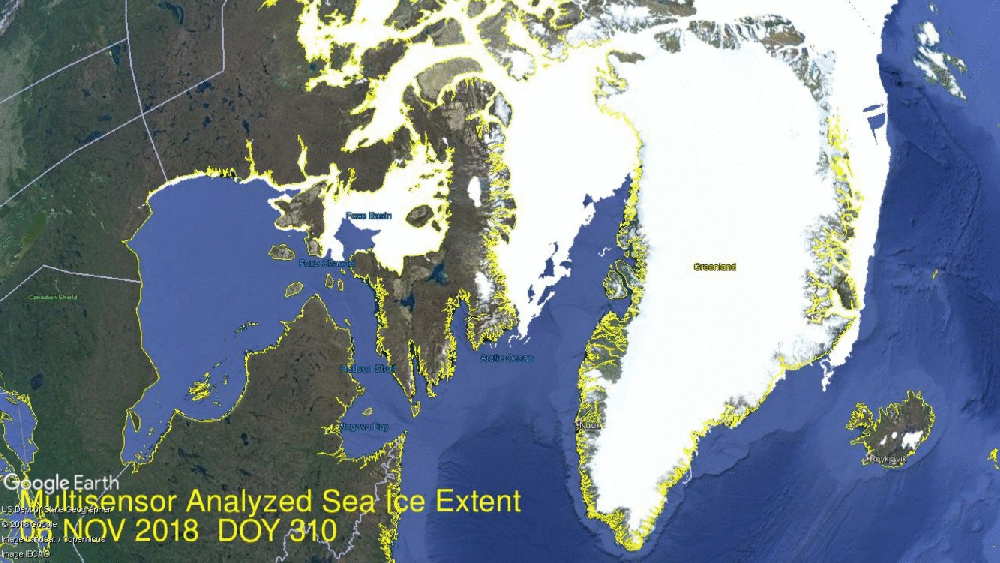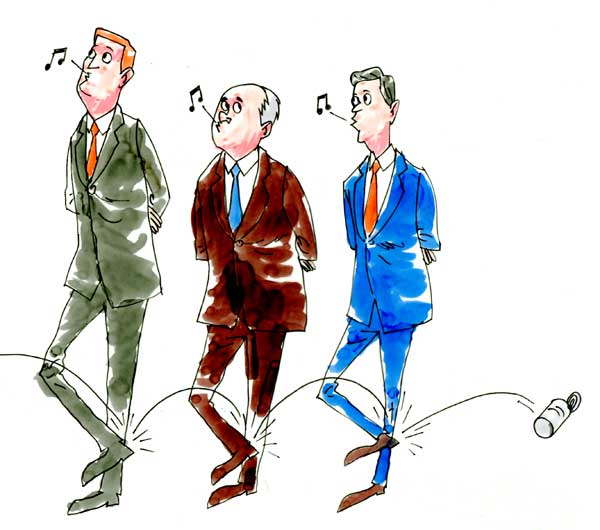
Updated Nov 23, 2018
As of Friday, Oregon District Court Judge Aiken has given into the Supreme Court suggestion and defendant’s request that a stay for interlocutory appeal be accepted by the lower court. The Order by Judge Aiken is here The key excerpt is in italics with my bolds.
This Court stands by its prior rulings on jurisdictional and merits issues, as well as its belief that this case would be better served by further factual development at trial. The Court has, however, reviewed the record and takes particular note of the recent orders issued by the United States Supreme Court on July 30, 2018, and November 2, 2018, as well as the extraordinary Order of the United States Court of Appeals for the Ninth Circuit in United States v. USDC-ORE, Case No. 18-73014 issued on November 8, 2018. At this time, the Court finds sufficient cause to revisit the question of interlocutory appeal as to its previous orders, and upon reconsideration, the Court finds that each of the factors outlined in § 1292(b) have been met regarding the previously mentioned orders. Thus, this Court now exercises its discretion and immediately certifies this case for interlocutory appeal. The Court does not make this decision lightly. Accordingly, this case is STAYED pending a decision by the Ninth Circuit Court of Appeals.
This means activity in preparation for an estimated 50 day trial is suspended while the higher Court of Appeals considers whether the lawsuit is out of bounds. See Background below.
Background from Previous Post on Nov. 5
As predicted in an earlier post (reprinted at the end), US lawyers are following the Supreme’s lead by again asking the Ninth Circuit Court of Appeals to dismiss the case. At the same time, one motion filed at the Oregon District Court asks for a stay of proceedings there pending a ruling by the Appeals Court. Another motion asks the Oregon court to again consider narrowing the scope of the lawsuit. The documents can be accessed at Columbia’s climate litigation website for Juliana vs. United States Some excerpts in italics with my bolds, followed by the Nov. 2 post.
From Petition to Court of Appeals:
If the district court grants certification and stays all proceedings, as the Supreme Court has signaled that it should, it will obviate the need for this Court’s intervention by way of mandamus. If, however, the district court declines to grant certification (despite the Supreme Court’s clear guidance to the contrary), this Court would need to intervene to provide the pretrial appellate review contemplated by the Supreme Court.
To be clear, the government hopes that this Court’s intervention through extraordinary relief will not be necessary. The government is doing everything in its power to persuade the district court to follow the Supreme Court’s guidance and to certify its decisions for interlocutory appeal. But if the district court declines to do so, this Court should intervene to provide the relief that the Supreme Court has expressly stated “may be available in” this Court — and that is plainly warranted given the fundamental defects in Plaintiffs’ action. ECF No. 416, at 2.
Previous Post Nov. 2, 2018: Supremes Kick Kids Lawsuit Down the Road
Last night the US Supreme justices refused the federal government’s petition to end the Oregon district court case. The media headlines will say this action allows the case to start, but that is not what happened. The real story concerns procedural hurdles and comes from Scotusblog, not from the green industry PR department (when did yellow journalism change colors?).
Everyone knows this issue will eventually come to the Supreme Court for a ruling. Some judges in black robes will take the heat for telling the truth about the case’s fatal legal flaws. So the Supremes will allow (not prevent) the lower courts to do their job to declare the suit out of bounds. All the while they know any lower ruling will be appealed by the losing side to the top later on.
As you will see, there are probably two more procedural maneuvers before the case can proceed to address the merits, or lack thereof. Yesterday, the Supremes noted that the Ninth District Court of Appeals twice refused the fed’s petition on grounds that no longer pertain. Thus, they suggest that the Ninth take a third kick at this can, perhaps this time actually engaging the issues.
If, as everyone expects, the Ninth follows their San Francisco-based leftist leanings and summarily grants no relief, then the feds can come back to the Supremes having no longer any recourse at lower levels. BTW, two Supreme Justices said they were ready now to grant the federal petition as it stands.
Amy Howe writes truthfully Justices refuse to block climate-change trial. Excerpts below in italics with my bolds.
Tonight the Supreme Court declined to intervene to block the trial in a lawsuit filed by a group of children and teenagers who have asked a federal district court in Oregon to order the federal government to prepare and put in place a plan to phase out fossil-fuel emissions. Although the justices’ ruling formally cleared the way for a trial in the case to go forward, the court stressed that the government may be able to get the relief that it is seeking in the U.S. Court of Appeals for the 9th Circuit, and it did not foreclose the possibility that the government could return to the Supreme Court yet again.
Text of Supreme Court Order ORDER IN PENDING CASE
This afternoon’s order was the latest chapter in the climate-change lawsuit, which was originally filed in 2015, during the Obama administration. The plaintiffs contend that the federal government’s conduct has led to a “dangerous climate system,” in conflict with their constitutional right to a “climate system capable of sustaining human life.”
The federal government first came to the Supreme Court in the case last summer, asking the justices to block discovery and a trial until the U.S. Court of Appeals for the 9th Circuit could rule on the government’s request to have the case dismissed or, at the very least, put on hold. But the justices declined to step in, describing the government’s request as “premature.” At the same time, the justices acknowledged that the plaintiffs’ claims are “striking” and that there are “substantial grounds for difference of opinion” on whether those claims belong in court at all; they also emphasized that the district court should “take these concerns into account in assessing the burdens of discovery and trial, as well as the desirability of a prompt ruling on” other motions that the government had filed seeking dismissal of the plaintiffs’ claims.
With a trial looming, the government returned to the Supreme Court again last week, complaining that the district court had declined to “meaningfully narrow” the scope of the case. It asked the justices to either end the lawsuit altogether or, at a minimum, review the district court’s rulings allowing the case to go forward. Chief Justice John Roberts, who at the time handled emergency requests from the geographic area that includes Oregon, agreed to put discovery and the trial on hold temporarily to give the plaintiffs an opportunity to respond to the government’s application.
In their response, the plaintiffs urged the justices to allow the trial to go forward. They noted that most pretrial fact-finding had already been completed, with the only remaining discovery “extremely limited.” The only harm that the government has cited to justify putting the trial on hold, the plaintiffs argued, is that it would otherwise be required to “participate in the normal process of trial and await appellate consideration until after final judgment” – which, in the plaintiffs’ view, is an “ordinary” burden rather than the kind of irreparable harm necessitating emergency relief. By contrast, they suggested, stopping the trial now “will disrupt the integrity of the judiciary’s role as a check on the political branches and will irreparably harm these children.” Indeed, the plaintiffs asserted, discovery and a trial are essential because the district court can’t decide the questions presented by their lawsuit, involving the plaintiffs’ legal right to bring the lawsuit and the allocation of power between the different branches of government, until the facts have been better developed.
In a reply brief, the federal government pushed back, telling the justices that it had made every possible effort in the lower courts to avoid reaching this point, but had been unsuccessful. The government emphasized that what the plaintiffs are asking the federal courts to do is extraordinary, “nothing less than a complete transformation of the American energy system – including the abandonment of fossil fuels.” Such a request, the government continued, “has no place in federal court,” so that granting the government a reprieve from the upcoming trial would “preserve the judiciary’s essential role under the Constitution.”
The government added that, contrary to the plaintiffs’ assurances, the prospect winning on appeal after an “extensive” trial had already taken place would provide little comfort to the government, because of the enormous amount of resources that would have to be devoted to pretrial preparations and the trial itself.
In an unsigned three-page order issued tonight, the Supreme Court explained that it would block the proceedings in the district court only if the government were likely to prevail on its request for an order of the Supreme Court, in particular, requiring the district court to dismiss the case. But the government cannot meet that standard, the justices continued, because it may be able to get the relief that it is seeking in the 9th Circuit. The court acknowledged that the 9th Circuit has twice turned down requests from the government to order the district court to dismiss the case, but it reasoned that the 9th Circuit did so because of the prospect that the plaintiffs’ claims against the government might eventually be dismissed through more conventional avenues. The justices concluded that those “reasons are, to a large extent, no longer pertinent” with a 50-day trial – which had been scheduled for October 29 – looming.
The court therefore denied the federal government’s request to keep the trial on hold “without prejudice” – that is, leaving open the possibility that the dispute could return to the Supreme Court again. The justices’ earlier order putting the trial on hold temporarily, to give them time to consider the government’s request, is terminated. Justices Clarence Thomas and Neil Gorsuch indicated that they would have granted the government’s request.
Background from previous post Supreme Justice Grants Stay of Kids Lawsuit
On Friday, Chief Justice Roberts stayed the discovery and trial of Juliana vs. US, pending responses from the plaintiffs to issues raised by the defense. Report from The News Review in italics with my bolds.
The U.S. Supreme Court on Friday granted a stay in the climate trial, Juliana v. United States, pending a response from the plaintiffs.
The Department of Justice asked the Supreme Court on Tuesday to dismiss the case brought by 21 young plaintiffs Thursday.
In a news release issued Friday afternoon, Meg Ward with Our Children’s Trust said the plaintiff’s legal team is working on its response, which it will file Monday.
The Supreme Court order states a response is due by Oct. 24.
Julia Olson, one of the lawyers representing the young plaintiffs, said the prosecution is confident that once the court receives the response the trial will proceed.
“As the Supreme Court has recognized in innumerable cases, review of constitutional questions is better done on a full record where the evidence is presented and weighed by the trier of fact,” Olson said in a news release.
The lawsuit alleges the federal government has violated young people’s constitutional rights through policies that have caused a dangerous climate.
They have said their generation bears the brunt of climate change and that the government has an obligation to protect natural resources for present and future generations.
The young people say government officials have known for more than 50 years that carbon pollution from fossil fuels was causing climate change and that policies on oil and gas deprive them of life, liberty and property. They also say the government has failed to protect natural resources as a “public trust” for future generations.
The lawsuit wants a court to order the government to stop permitting and authorizing fossil fuels, quickly phase out carbon dioxide emissions to a certain level by 2100 and develop a national climate recovery plan.
The Trump administration got a temporary reprieve on the case after also asking the 9th U.S. Circuit Court of Appeals, which rejected the request in July.
“The latest attempt to get the U.S. Supreme Court to stop the trial does not appear to be based on any new evidence or arguments. The only new element is an additional Supreme Court justice,” said Melissa Scanlan, a professor at Vermont Law School, who is not involved in the case.
Kavanaugh replaced the more moderate Anthony Kennedy.
Scanlan said the Trump administration is trying to avoid “what they’re expecting to be a 50-day trial focused on climate disruption.” The trial in Eugene was expected to wrap up in January.
CNN added this:
Solicitor General Noel Francisco asked the justice to stop any further discovery and the pending trial while the government appeals the lower court opinion.
In his filing, Francisco lambasted the suit, calling it “an attempt to redirect federal environmental and energy policies through the courts rather than through the political process, by asserting a new and unsupported fundamental due process right to certain climate conditions.”
Francisco’s language echoes some of the remarks Attorney General Jeff Sessions made before the conservative Heritage Foundation on Monday. “Judicial activism is therefore a threat to our representative government and the liberty it secures,” Sessions said. “In effect, activist advocates want judges who will do for them what they have been unable to achieve at the ballot box. It is fundamentally undemocratic.”
The filings may be welcomed by some of the justices but they also put others in an uncomfortable position, and there’s a risk of going to the well too often.
“The Supreme Court unquestionably has the authority to provide the extraordinary relief the government is seeking in these cases,” said Steve Vladeck, CNN Supreme Court analyst and professor at the University of Texas School of Law.
“That said, it tends to exercise that authority sparingly,” he added,” and there’s reason to wonder if the government, by repeatedly asking for such unusual relief, might be perceived by at least some of the justices as the boy who cried wolf.”
The text of the US filing is PETITION FOR A WRIT OF MANDAMUS Contents:
Reasons for granting the petition
A. The government has a clear and indisputable
right to relief from the district court’s refusal to
dismiss this fundamentally misguided suit
1. The district court clearly and indisputably
erred by exercising jurisdiction over the suit
2. The district court clearly and indisputably
erred by allowing the claims to proceed
outside the binding framework of the APA
3. The district court clearly and indisputably
erred by allowing the claims to proceed on the
merits
B. The government has no other adequate means to
attain relief from a fundamentally misguided and
improper trial
C. Mandamus relief is appropriate under the
circumstances
Excerpt from page 26:
Remarkably, the district court rooted its recognition of a fundamental due process right to “a climate system capable of sustaining human life,” App., infra, 141a, in this Court’s recognition of a fundamental right to samesex marriage in Obergefell v. Hodges, 135 S. Ct. 2584 (2015). There is no relationship, however, between a distinctly personal and circumscribed right to same-sex marriage and the alleged right to a climate system capable of sustaining human life that apparently would run indiscriminately to every individual in the United States. The right recognized by the district court has no relationship to any right as “fundamental as a matter of history and tradition” as the right to marry recognized in Obergefell. Id. at 2602.
Background from previous post Supremes Looking at Kids Lawsuit
An Oregon liberal judge is determined to put climate change on trial in Juliana vs US, scheduled to start on October 29, 2018. But now another pitfall stands in the way. The Trump administration has asked the Supreme Court to review the legitimacy of the scope of the kids’ claims they have a right to an unchanging favorable climate provided to them by the federal government. Here is the update from Scotusblog by Amy Howe Government returns in climate change lawsuit Excerpts in italics with my bolds.
In July, the Supreme Court declined to intervene in a lawsuit filed by a group of 21 children and teenagers who allege that they have a constitutional right to a “climate system capable of sustaining human life.” The justices rejected the federal government’s request to block discovery and a trial until the U.S. Court of Appeals for the 9th Circuit could rule on the government’s petition seeking to have the case dismissed or, at a minimum, to block discovery and the trial temporarily. Today the Trump administration returned to the Supreme Court, asking it once again to put discovery and the trial – now scheduled for the end of October – on hold.
The case was originally filed in 2015 against the Obama administration. The plaintiffs argue that the federal government’s actions are causing a “dangerous climate system,” and they have asked a federal district court in Oregon to order various federal agencies to prepare and implement a remedial plan to phase out fossil-fuel emissions.
When the government asked the justices to step in over the summer, they rejected the request, which they described as “premature.” But the justices also seemed to express some skepticism about the “breadth” of the plaintiffs’ claims, calling them “striking” and observing that there are “substantial grounds for difference of opinion” on whether those claims belong in court at all. The justices instructed the district court to “take these concerns into account in assessing the burdens of discovery and trial, as well as the desirability of a prompt ruling on the” federal government’s other pending motions, which could result in dismissal of some or all of the plaintiffs’ claims.
The government is now back at the court, telling the justices that earlier this week the district court “declined to meaningfully narrow” the plaintiffs’ claims, instead rejecting various government motions that would have ended the case. The government is now asking the court to order the district court to “end this profoundly misguided suit” or, at the very least, review the district court’s rulings allowing the case to go forward; moreover, the government again urges, the Supreme Court should put discovery and the trial on hold while it considers these requests. There would be no real harm to the plaintiffs from doing so, the government stresses, because the plaintiffs are claiming that they have been harmed by the cumulative effects of carbon dioxide emissions over several decades.
The government’s request, signed by U.S. solicitor general Noel Francisco, goes to Chief Justice John Roberts, who currently serves as the circuit justice for the 9th Circuit. Roberts can act on the government’s application immediately or refer it to the full court.

Economist Joseph Stiglitz writes of climate change: “There is a point at which, once this harm occurs, it cannot be undone at any reasonable cost or in any reasonable period of time. Based on the best available science, our country is close to approaching that point.” Credit: Win McNamee/Getty Images
For an insight into the claims being made on behalf of the kids, here is a reprint of a previous post analyzing a brief filed by an IPCC insider.
Climatists Make Their Case by Omitting Facts
One of the world’s top economists has written an expert court report that forcefully supports a group of children and young adults who have sued the federal government for failing to act on climate change. (Source: Inside Climate News here) Excerpts in italics with my bolds.
Stiglitz, a Columbia University economics professor and former World Bank chief economist, concludes that increasing global warming will have huge costs on society and that a fossil fuel-based system “is causing imminent, significant, and irreparable harm to the Youth Plaintiffs and Affected Children more generally.” He explains in a footnote that his analysis also examines impacts on “as-yet-unborn youth, the so-called future generations.”
But, he says, acting on climate change now—by imposing a carbon tax and cutting fossil fuel subsidies, among other steps—is still manageable and would have net-negative costs. He argues that if the government were to pursue clean energy sources and energy-smart technologies, “the net benefits of a policy change outweigh the net costs of such a policy change.”
“Defendants must act with all deliberate speed and immediately cease the subsidization of fossil fuels and any new fossil fuel projects, and implement policies to rapidly transition the U.S. economy away from fossil fuels,” Stiglitz writes. “This urgent action is not only feasible, the relief requested will benefit the economy.”
Stiglitz has been examining the economic impact of global warming for many years. He was a lead author of the 1995 report of the UN’s Intergovernmental Panel on Climate Change, an authoritative assessment of climate science that won the IPCC the 2007 Nobel Peace Prize, shared with Al Gore.
The Stiglitz expert report submitted to the court is here.
An Example of Intentional Omissions
Since this is a legal proceeding, Stiglitz wrote a brief telling the plaintiffs’ side of the story. In a scientific investigation, parties would assert theories attempting to explain all of the evidence at hand. Legal theories have no such requirement to incorporate all the facts, but rather present conclusions informed by the evidence deemed strongest and most pertinent to one party’s interests.

While the Pope accuses us with the Sin of Emissions, we counter with the Sins of Omissions by him and his fellow activists.
Let’s consider the Stiglitz brief according to the three suppositions comprising the Climatist (Activists and Alarmists) position. Climate change is a bundle that depends on all three assertions to be true.

Supposition 1: Humans make the climate warmer.
As an economist, Stiglitz defers to the IPCC on this scientific point, with references to reports by those deeply involved and committed to Paris Accord and other UN climate programs. In the recent California District Court case (Cities suing Big Oil companies), both sides in a similar vein stipulated their acceptance of IPCC reports as authoritative regarding global warming/climate change.
Skeptical observers must attend to the nuances of what is referenced and what is hidden or omitted in these testimonies. For example, Chevron’s attorney noted that IPCC’s reports express various opinions over time as to human influence on the climate. They noted that even today, the expected temperature effect from doubling CO2 ranges widely from 1.5C to 4.5C. No mention is made that several more recent estimates from empirical data (rather than GCMs) are at the low end or lower.

In addition, there is no mention that GCMs projections are running about twice as hot as observations. Omitted is the fact GCMs correctly replicate tropospheric temperature observations only when CO2 warming is turned off. In the effort to proclaim scientific certainty, neither Stiglitz nor IPCC discuss the lack of warming since the 1998 El Nino, despite two additional El Ninos in 2010 and 2016.

Figure 5. Simplification of IPCC AR5 shown above in Fig. 4. The colored lines represent the range of results for the models and observations. The trends here represent trends at different levels of the tropical atmosphere from the surface up to 50,000 ft. The gray lines are the bounds for the range of observations, the blue for the range of IPCC model results without extra GHGs and the red for IPCC model results with extra GHGs.The key point displayed is the lack of overlap between the GHG model results (red) and the observations (gray). The nonGHG model runs (blue) overlap the observations almost completely.
Further they exclude comparisons between fossil fuel consumption and temperature changes. The legal methodology for discerning causation regarding work environments or medicine side effects insists that the correlation be strong and consistent over time, and there be no confounding additional factors. As long as there is another equally or more likely explanation for a set of facts, the claimed causation is unproven. Such is the null hypothesis in legal terms: Things happen for many reasons unless you can prove one reason is dominant.

Finally, Stiglitz and IPCC are picking on the wrong molecule. The climate is controlled not by CO2 but by H20. Oceans make climate through the massive movement of energy involved in water’s phase changes from solid to liquid to gas and back again. From those heat transfers come all that we call weather and climate: Clouds, Snow, Rain, Winds, and Storms.
Esteemed climate scientist Richard Lindzen ended a very fine recent presentation with this description of the climate system:
I haven’t spent much time on the details of the science, but there is one thing that should spark skepticism in any intelligent reader. The system we are looking at consists in two turbulent fluids interacting with each other. They are on a rotating planet that is differentially heated by the sun. A vital constituent of the atmospheric component is water in the liquid, solid and vapor phases, and the changes in phase have vast energetic ramifications. The energy budget of this system involves the absorption and reemission of about 200 watts per square meter. Doubling CO2 involves a 2% perturbation to this budget. So do minor changes in clouds and other features, and such changes are common. In this complex multifactor system, what is the likelihood of the climate (which, itself, consists in many variables and not just globally averaged temperature anomaly) is controlled by this 2% perturbation in a single variable? Believing this is pretty close to believing in magic. Instead, you are told that it is believing in ‘science.’ Such a claim should be a tip-off that something is amiss. After all, science is a mode of inquiry rather than a belief structure.
Supposition 2: The Warming is Dangerous
Billions of dollars have been spent researching any and all negative effects from a warming world: Everything from Acne to Zika virus. Stiglitz links to a recent Climate Report that repeats the usual litany of calamities to be feared and avoided by submitting to IPCC demands. The evidence does not support these claims.
Stiglitz: It is scientifically established that human activities produce GHG emissions, which accumulate in the atmosphere and the oceans, resulting in warming of Earth’s surface and the oceans, acidification of the oceans, increased variability of climate, with a higher incidence of extreme weather events, and other changes in the climate.
Moreover, leading experts believe that there is already more than enough excess heat in the climate system to do severe damage and that 2C of warming would have very significant adverse effects, including resulting in multi-meter sea level rise.
Experts have observed an increased incidence of climate-related extreme weather events, including increased frequency and intensity of extreme heat and heavy precipitation events and more severe droughts and associated heatwaves. Experts have also observed an increased incidence of large forest fires; and reduced snowpack affecting water resources in the western U.S. The most recent National Climate Assessment projects these climate impacts will continue to worsen in the future as global temperatures increase.
Alarming Weather and Wildfires
But: Weather is not more extreme.
 And Wildfires were worse in the past.
And Wildfires were worse in the past.
 But: Sea Level Rise is not accelerating.
But: Sea Level Rise is not accelerating.
 Litany of Changes
Litany of Changes
Seven of the ten hottest years on record have occurred within the last decade; wildfires are at an all-time high, while Arctic Sea ice is rapidly diminishing.
We are seeing one-in-a-thousand-year floods with astonishing frequency.
When it rains really hard, it’s harder than ever.
We’re seeing glaciers melting, sea level rising.
The length and the intensity of heatwaves has gone up dramatically.
Plants and trees are flowering earlier in the year. Birds are moving polewards.
We’re seeing more intense storms.
But: Arctic Ice has not declined since 2007.

But: All of these are within the range of past variability.

In fact our climate is remarkably stable.

And many aspects follow quasi-60 year cycles.

Climate is Changing the Weather
Stiglitz: Other potential examples include agricultural losses. Whether or not insurance
reimburses farmers for their crops, there can be food shortages that lead to higher food
prices (that will be borne by consumers, that is, Youth Plaintiffs and Affected Children).
There is a further risk that as our climate and land use pattern changes, disease vectors
may also move (e.g., diseases formerly only in tropical climates move northward).36 This
could lead to material increases in public health costs
But: Actual climate zones are local and regional in scope, and they show little boundary change.

But: Ice cores show that it was warmer in the past, not due to humans.

Supposition 3: Government Can Stop it!
Here it is blithely assumed that the court can rule the seas to stop rising, heat waves to cease, and Arctic ice to grow (though why we would want that is debatable). All this will be achieved by leaving fossil fuels in the ground and powering civilization with windmills and solar panels. While admitting that our way of life depends on fossil fuels, they ignore the inadequacy of renewable energy sources at their present immaturity.

Stiglitz: Conclusion
The choice between incurring manageable costs now and the incalculable, perhaps even
irreparable, burden Youth Plaintiffs and Affected Children will face if Defendants fail to
rapidly transition to a non-fossil fuel economy is clear. While the full costs of the climate
damages that would result from maintaining a fossil fuel-based economy may be
incalculable, there is already ample evidence concerning the lower bound of such costs,
and with these minimum estimates, it is already clear that the cost of transitioning to a
low/no carbon economy are far less than the benefits of such a transition. No rational
calculus could come to an alternative conclusion. Defendants must act with all deliberate
speed and immediately cease the subsidization of fossil fuels and any new fossil fuel
projects, and implement policies to rapidly transition the U.S. economy away from fossil
fuels.
But CO2 relation to Temperature is Inconsistent.

But: The planet is greener because of rising CO2.

But: Modern nations (G20) depend on fossil fuels for nearly 90% of their energy.
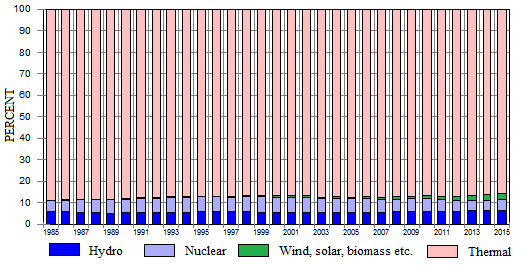
But: Renewables are not ready for prime time.
People need to know that adding renewables to an electrical grid presents both technical and economic challenges. Experience shows that adding intermittent power more than 10% of the baseload makes precarious the reliability of the supply. South Australia is demonstrating this with a series of blackouts when the grid cannot be balanced. Germany got to a higher % by dumping its excess renewable generation onto neighboring countries until the EU finally woke up and stopped them. Texas got up to 29% by dumping onto neighboring states, and some like Georgia are having problems.
But more dangerous is the way renewables destroy the economics of electrical power. Seasoned energy analyst Gail Tverberg writes:
In fact, I have come to the rather astounding conclusion that even if wind turbines and solar PV could be built at zero cost, it would not make sense to continue to add them to the electric grid in the absence of very much better and cheaper electricity storage than we have today. There are too many costs outside building the devices themselves. It is these secondary costs that are problematic. Also, the presence of intermittent electricity disrupts competitive prices, leading to electricity prices that are far too low for other electricity providers, including those providing electricity using nuclear or natural gas. The tiny contribution of wind and solar to grid electricity cannot make up for the loss of more traditional electricity sources due to low prices.
These issues are discussed in more detail in the post Climateers Tilting at Windmills
Footnote regarding mention of “multi-meter” sea level rise. It is all done with computer models. For example, below is San Francisco. More at USCS Warnings of Coastal Floodings
















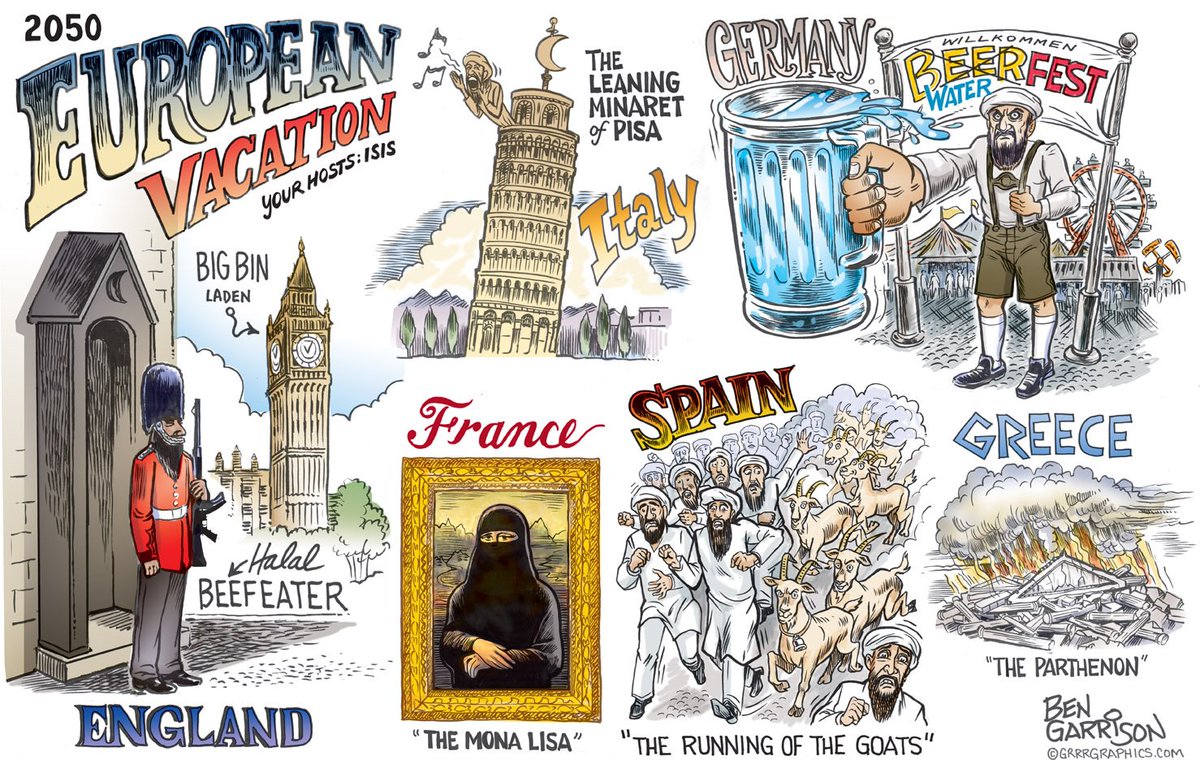



















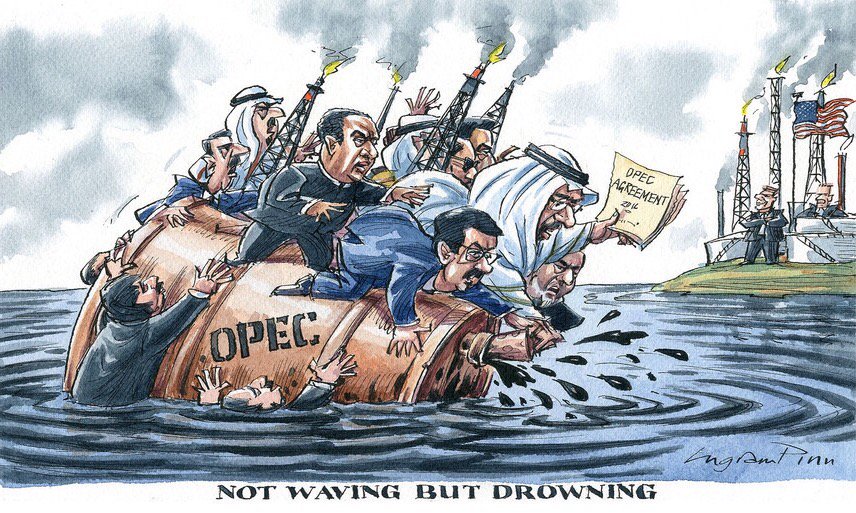







 And Wildfires were worse in the past.
And Wildfires were worse in the past. But: Sea Level Rise is not accelerating.
But: Sea Level Rise is not accelerating. Litany of Changes
Litany of Changes











